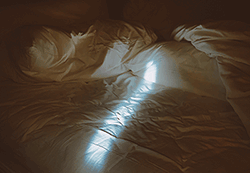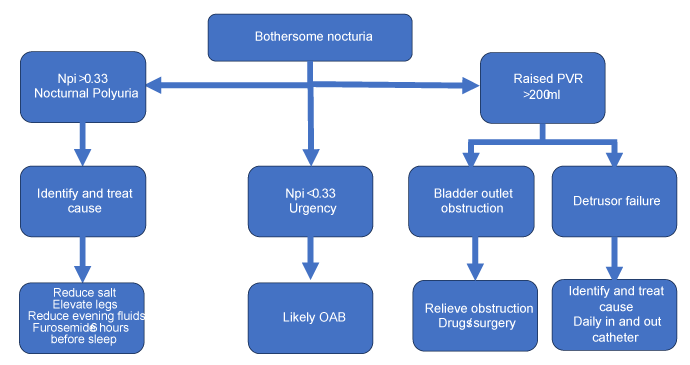Nocturia
September 14, 2023

 Contributed by:
Contributed by:
William Gibson MBChB (MD) PhD FRCP – View bio
Case
Beryl is 76 years old and attends her family doctor as she has been feeling tired. She reports that over the last year she has been woken several times at night by the urge to pass urine and finds it difficult to get back to sleep. She has a past history of hypertension, diabetes mellitus and obesity. Her current medication comprises furosemide 40mg, amlodipine 10mg, metformin 1g twice daily, empagliflozin 25mg and perindopril 2mg. Her most recent HbA1C is 5.8%. Her hemoglobin and TSH are both within normal limits. Examination reveals oedema bilaterally but no signs of congestive cardiac failure, and her pelvic exam is normal with no pelvic organ prolapse. Her blood pressure was 105/68. Her urinalysis was normal other than heavy glycosuria.
Issue
Beryl is describing nocturia, the complaint of passing urine during the main sleep period, with each urination followed by sleep or the intention to sleep.1 Why is Beryl waking overnight to go to the toilet and how can this be improved?
Background
Nocturia is common in the general population and increases in prevalence with increasing age. The prevalence in men and women aged over 60 is around 70%.2 Nocturia is associated with numerous negative health outcomes including falls and fractures,3 and excess mortality.4 Nocturia also causes daytime somnolence, impaired cognitive function and impaired quality of life. Although any instance of waking to void meets the definition of nocturia, the majority of patients will only complain when their nocturia occurs twice or more per night. Nocturia is not synonymous with nocturnal polyuria, the excessive production of urine at night.
Evidence
The ability to sleep through the night undisturbed by the need to pass urine is dependent on the entirety of the night’s urine production being contained within the bladder for voiding upon planned waking. This is, in turn, determined by the functional bladder capacity, being the difference in maximum capacity and post-void residual, and the nocturnal urine volume.
Nocturnal polyuria
Humans, being diurnal, have evolved to produce the majority of their urine output during the day.1 This is achieved through a surge of anti-diuretic hormone released at the onset of sleep, which develops around the age of three. In older adults, this nocturnal ADH secretion is reduced, leading to an increase in nocturnal urine production.5 In addition to this, many comorbidities and medications may increase nocturnal urine production. Oedema of any cause; including congestive cardiac failure, gravitational and iatrogenic will redistribute when recumbent at night, leading to diuresis. Hyperglycemia and other osmotic diureses, paroxysmal atrial fibrillation and obstructive sleep apnea also increase nocturnal urine production and should be considered.
Nocturnal polyuria is diagnosed with a three-day bladder diary with the individual recording the time, urgency and volume of each void for three consecutive days. The volume of voids after the onset of sleep, including the first void of the day, is added and divided by the total 24-hour urine volume, to give the Nocturnal Polyuria index (NPi). A value of >33% is diagnostic of nocturnal polyuria.
Overactive bladder
Overactive bladder (OAB) is the clinical syndrome of urinary urgency, usually accompanied by increased daytime frequency and/or nocturia, with urinary incontinence (OAB-wet) or without (OAB-dry), in the absence of urinary tract infection or other detectable disease.6 Some patients will have relatively mild OAB symptoms by day but be significantly affected at night.
Impaired bladder emptying
The post-void residual volume (PVR), the volume of urine in the bladder at the completion of voiding, rises with normal ageing, and may be caused by a number of comorbidities and medications. When high, the functional capacity of the bladder is reduced; for example, an individual with a maximum bladder capacity of 550ml and a residual of 400ml will only be able to hold 150ml of urine, leading to frequency and nocturia. Diabetes mellitus, neurological conditions such as multiple sclerosis, constipation and bladder outlet obstruction with an enlarged prostate in men or pelvic organ prolapse in women can also lead to a raised PVR.
Assessment
A detailed history should be taken to establish the circumstances and volume of nocturia and the presence of daytime lower urinary tract symptoms, the perceived volume of voids by day and by night, and any voiding symptoms such as slow stream or sensation of impaired emptying. Past medical history and a detailed drug history, including over-the-counter medications should also be recorded. Examination including for oedema, pelvic and/or rectal exam, and a post-void residual should be performed. A three-day bladder diary and calculation of the NPi is essential to distinguish between nocturnal polyuria and nocturia with low urine production.
Based on this, the nocturia can be classified as nocturnal polyuria, OAB or impaired emptying, and the underlying cause identified and treated.
Treatment of nocturnal polyuria
NP is often best treated by treating the underlying cause, removing contributing factors such as drugs and conservative methods including daytime salt reduction, reducing fluid intake after 6 p.m., and elevating the legs when sitting. If this fails, giving a small dose of furosemide six hours before bedtime can cause an evening diuresis and thereby reduce nighttime urine production. DDAVP given at bedtime is effective but carries a risk of hyponatremia. The serum sodium level should be measured pre-treatment and on day three, and patients warned of the symptoms of hyponatremia.
Treatment of OAB
The treatment of OAB is initially conservative, with normalization of fluid intake, caffeine reduction, treating constipation and with bladder training. If pharmacological treatment is indicated, then solifenacin,7 fesoterodine8 and mirabegron9 have better safety data in older people than oxybutynin.10
Treatment of impaired bladder emptying
A raised PVR in the presence of bladder outlet obstruction, usually in men with prostatic enlargement, requires relief, either pharmacologically with alpha blockers or 5AR inhibitors or surgically. In the absence of obstruction, then any underlying causes, such as constipation or medications which impair bladder emptying, should be addressed. In the absence of a treatable cause, the practice of double voiding, where the patient makes a conscious effort to void twice may help. If not, then a once-daily in-and-out catheter at bedtime can allow the person to go to sleep with an empty bladder and not need to void until morning.
Summary
On detailed history, Beryl reported that she was started on amlodipine when admitted to hospital with pneumonia and was hypertensive on one occasion. She developed leg swelling after this and was then started on furosemide to manage her oedema. Her bladder diary revealed an NPi of 60%, indicating nocturnal polyuria. Her amlodipine and furosemide were discontinued and given her well-controlled diabetes, her empagliflozin was stopped. On review four weeks later, her oedema had resolved and her nocturia reduced to one, with several nights without nocturia in a normal week.

Causes of nocturia
Nocturnal Polyuria
- Excessive evening fluid intake
- Redistribution of peripheral oedema
- Congestive cardiac failure
- Gravitational
- Hypoalbuminemia
- Drugs
- Calium channel blockers
- NSAIDs
- Corticosteroids
- Fludrocortisone
- Gabapentinoids
- Reduced ADH secretion
- Hyperglycemia
- OSA
- Paroxysmal AF overnight
Overactive Bladder
- Daytime urgency and frequency
- Nocturnal urgency
- Urgency incontinence
Impaired emptying
- Bladder outlet obstruction
- Benign prostatic enlargement
- Constipation
- Surgery for stress incontinence
- Rectal tumours
- Urethral stricture
- Impaired detrusor contraction
- Drugs
- Anticholinergics
- Antipsychotics
- Gabapentinoids
- Benzodiazepines
- Opioids
- Alpha blockers
- Calcium channel antagonists
- Neurological disease
- Multiple sclerosis
- Diabetic nephropathy/cystopathy
- Parkinson’s disease
- Stroke
- Drugs
References
- D'Ancona, C., Haylen, B., Oelke, M., Abranches-Monteiro, L., Arnold, E., Goldman, H., Hamid, R., Homma, Y., Marcelissen, T., Rademakers, K., Schizas, A., Singla, A., Soto, I., Tse, V., de Wachter, S., Herschorn, S., Standardisation Steering Committee, I.C.S., the, I.C.S.W.G.o.T.f.M.L.U.T., Pelvic Floor, S., and Dysfunction, The International Continence Society (ICS) report on the terminology for adult male lower urinary tract and pelvic floor symptoms and dysfunction. Neurourol Urodyn, 2019. 38(2): p. 433-477.
- Irwin, D.E., Milsom, I., Hunskaar, S., Reilly, K., Kopp, Z., Herschorn, S., Coyne, K., Kelleher, C., Hampel, C., Artibani, W., and Abrams, P., Population-based survey of urinary incontinence, overactive bladder, and other lower urinary tract symptoms in five countries: results of the EPIC study. Eur Urol, 2006. 50(6): p. 1306-14; discussion 1314-5.
- Pesonen, J.S., Vernooij, R.W.M., Cartwright, R., Aoki, Y., Agarwal, A., Mangera, A., Markland, A.D., Tsui, J.F., Santti, H., Griebling, T.L., Pryalukhin, A.E., Riikonen, J., Tahtinen, R.M., Vaughan, C.P., Johnson, T.M., 2nd, Heels-Ansdell, D., Guyatt, G.H., and Tikkinen, K.A.O., The Impact of Nocturia on Falls and Fractures: A Systematic Review and Meta-Analysis. J Urol, 2020. 203(4): p. 674-683.
- Moon, S., Kim, Y.J., Chung, H.S., Yu, J.M., Park, II, Park, S.G., Pak, S., Kwon, O., Lee, Y.G., and Cho, S.T., The Relationship Between Nocturia and Mortality: Data From the National Health and Nutrition Examination Survey. Int Neurourol J, 2022. 26(2): p. 144-152.
- Asplund, R. and Aberg, H., Diurnal variation in the levels of antidiuretic hormone in the elderly. J Intern Med, 1991. 229(2): p. 131-4.
- Haylen, B.T., de Ridder, D., Freeman, R.M., Swift, S.E., Berghmans, B., Lee, J., Monga, A., Petri, E., Rizk, D.E., Sand, P.K., Schaer, G.N., International Urogynecological, A., and International Continence, S., An International Urogynecological Association (IUGA)/International Continence Society (ICS) joint report on the terminology for female pelvic floor dysfunction. Neurourol Urodyn, 2010. 29(1): p. 4-20.
- Wagg, A., Khullar, V., Michel, M.C., Oelke, M., Darekar, A., and Bitoun, C.E., Long-term safety, tolerability and efficacy of flexible-dose fesoterodine in elderly patients with overactive bladder: open-label extension of the SOFIA trial. Neurourol Urodyn, 2014. 33(1): p. 106-14.
- Wagg, A., Khullar, V., Marschall-Kehrel, D., Michel, M.C., Oelke, M., Darekar, A., Bitoun, C.E., Weinstein, D., and Osterloh, I., Flexible-dose fesoterodine in elderly adults with overactive bladder: results of the randomized, double-blind, placebo-controlled study of fesoterodine in an aging population trial. J Am Geriatr Soc, 2013. 61(2): p. 185-93.
- Herschorn, S., Staskin, D., Schermer, C.R., Kristy, R.M., and Wagg, A., Safety and Tolerability Results from the PILLAR Study: A Phase IV, Double-Blind, Randomized, Placebo-Controlled Study of Mirabegron in Patients ≥ 65 years with Overactive Bladder-Wet. Drugs Aging, 2020. 37(9): p. 665-676.
- Gibson, W., Athanasopoulos, A., Goldman, H., Madersbacher, H., Newman, D., Spinks, J., Wyndaele, J.J., and Wagg, A., Are we shortchanging frail older people when it comes to the pharmacological treatment of urgency urinary incontinence? Int J Clin Pract, 2014. 68(9): p. 1165-73.
